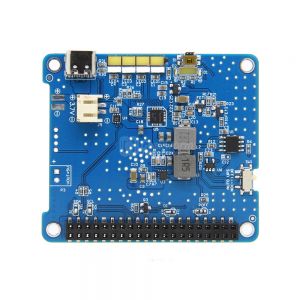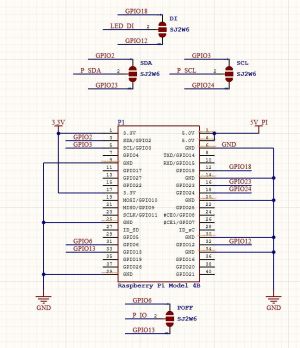UPS3
Contents
Overview
UPS3 is the upgrade version of UPS2, we solve some questions of UPS2.
NOTE: UPS 3 ONLY supports Linux OS, DON'T use UPS 3 on windows OS.
Features
- Raspberry Pi standard HAT size, all components under the PCB board, and the use of 5mm high female socket, can reduce the thickness of the expansion board, easy to put into the shell. You can use the header to increase the height.
- Equipped with a custom long header (This is optional accessories)
- Supports power supply of TYPE-C.
- Type-C power supply interface is compatible with a variety of fast charge standard PD2.0/QC3.0/QC2.0 (5V/3A); Default 3A charging current, integrated chip will intelligently adjust the charging current according to the battery and power capabilities
- Up to maximum 3A current output;
- Long press power button 2 seconds to power on / off
- With 4 LED power indicator (controlled by program, please refer to User Manual)
- Supports AUTO POWER ON function (need to select the AUTO UPS switch to ON)
- Use TI battery monitoring IC with patented Impedance Track algorithm
- Support I2C communication to read battery capacity, voltage, charge status and battery life (please refer to status.py)
- With charge and discharge protection and overheat protection
- The capacity of Lithium Battery MUST be more than 2500mAh, you can use the more big capacity battery. PS: Voltage must be 3.7V. The connector specification is: PH 2.02-PIN connector
Packing List
- 1 x UPS HAT 3 Board
User Manual
- UPS3 power off guide
- The charge level indicators (RGB LED) is controlled by program, script please refer to Github: https://github.com/geekworm-com/ups3
please download it from here:File:Ups3-master.zip then unzip if you can't download it from github.com
sudo rpi-update
sudo apt-get update
sudo apt-get dist-upgrade
git clone https://github.com/geekworm-com/ups3.git
cd ups3
chmod +x *.sh *.py
sudo ./install.sh
┌────────────────────┤ UPS V3 Setting ├────────────────────┐
│ Select the appropriate options: │
│ │
│ 1 UPS GPIO [ 18 ] │
│ 2 LED Brightness [ 10% ] │
│ 3 Poweoff power [ <5% ] │
│ 4 Auto run script [ enabled ] │
│ 5 Safe shutdown [ enabled ] │
│ 6 Apply Settings │
│ 7 Remove │
│ 8 Exit │
│ │
│ │
│ │
│ │
│ <Ok> │
│ │
└──────────────────────────────────────────────────┘
View Status:
sudo python status.py or sudo python status.py -t
View logs:
cat /var/log/smartups.log
FAQ
Q1: Customer feedback 1: I have an issue with UPS hat 3. I tried to use battery from the old tablet and pack of cells, but none of them work well and the raspberry is turning off about 0.5 to 1 second after disconnecting the power. I'm not sure, that it's problem of batteries or hat itself. Do you have any suggestions what is wrong? Could you suggest which batteries works best?
A: I guess, I found the reason why the UPS hat is not working properly. My raspberry pi is overclocked to 2.0GHz and also has increased voltage. When I use the defaults voltage and clock values in the configuration file it works better, but still I think my batteries are too weak. I'll do more tests and let you know. Currently, I find it important to note that overclocking is bad for the condition of the UPS 3 hat.
Q:Is it allowed to supply 12VDC directly to VCC and GND wires of the USB-connector ?
A: Yes, it is ok to use 12VDC directly.
Q2: We want automatic shutdown when the external AC power supply is disconnected, is possible?
A: Yes. you can program a script to get this function. Example (The following is a pseudo code):
while (1) {
// invoke the API to get AC PSU status: connected or disconnected
int disconnected_flag = getACPSUStatus(); // please refer to the user manual to achieve getACPSUStatus function;
int battery_voltage = getBatteryVoltage(); // please refer to the user manual to achieve getBatteryVoltagefunction;
// You can make your own actions based on disconnected_flag and battery_voltage, you can only select one condition also
if (disconnected_flag) {
// execute linux or software shutdown command
}
sleep(10);
}
Q3: How to restart the pi board when AC Power supply is connected?
A: Please enable 'AUTO POWER ON' or 'AUTO ON' function if you want restart when the AC Power supply is reapplied.
Q4: Why the Raspberry Pi can't turn on after install the UPS3?
A: Please pay attention to the UPS3 board installation directions, this is wrong.









Enable comment auto-refresher
Anonymous user #22
Permalink |
Walker
Anonymous user #21
Permalink |
Anonymous user #20
Permalink |
Lisa
Anonymous user #19
Permalink |
Anonymous user #18
Permalink |
Lisa
Anonymous user #18
Permalink |
Lisa
Anonymous user #17
Permalink |
Lisa
Anonymous user #14
Permalink |
Lisa
Anonymous user #16
Permalink |
Lisa
Anonymous user #15
Permalink |
Lisa
Anonymous user #15
Lisa
Anonymous user #14
Permalink |
Lisa
Anonymous user #14
Permalink |
Lisa
Anonymous user #14
Permalink |
Lisa
Anonymous user #13
Permalink |
Lisa
Anonymous user #12
Permalink |
Lisa
Anonymous user #11
Permalink |
Lisa
Anonymous user #10
Permalink |
Lisa
Anonymous user #9
Permalink |
Lisa
Anonymous user #8
Permalink |
Xiali
Permalink |
Anonymous user #7
Permalink |
Rwagnon
Permalink |
Anonymous user #6
Permalink |
Anonymous user #6
Anonymous user #5
Permalink |
Anonymous user #4
Permalink |
Anonymous user #3
Permalink |
Anonymous user #3
Permalink |
Harry
Swereska
Permalink |
Xiali
Anonymous user #2
Permalink |
Harry
Serveurperso
Permalink |
Anonymous user #1
Permalink |